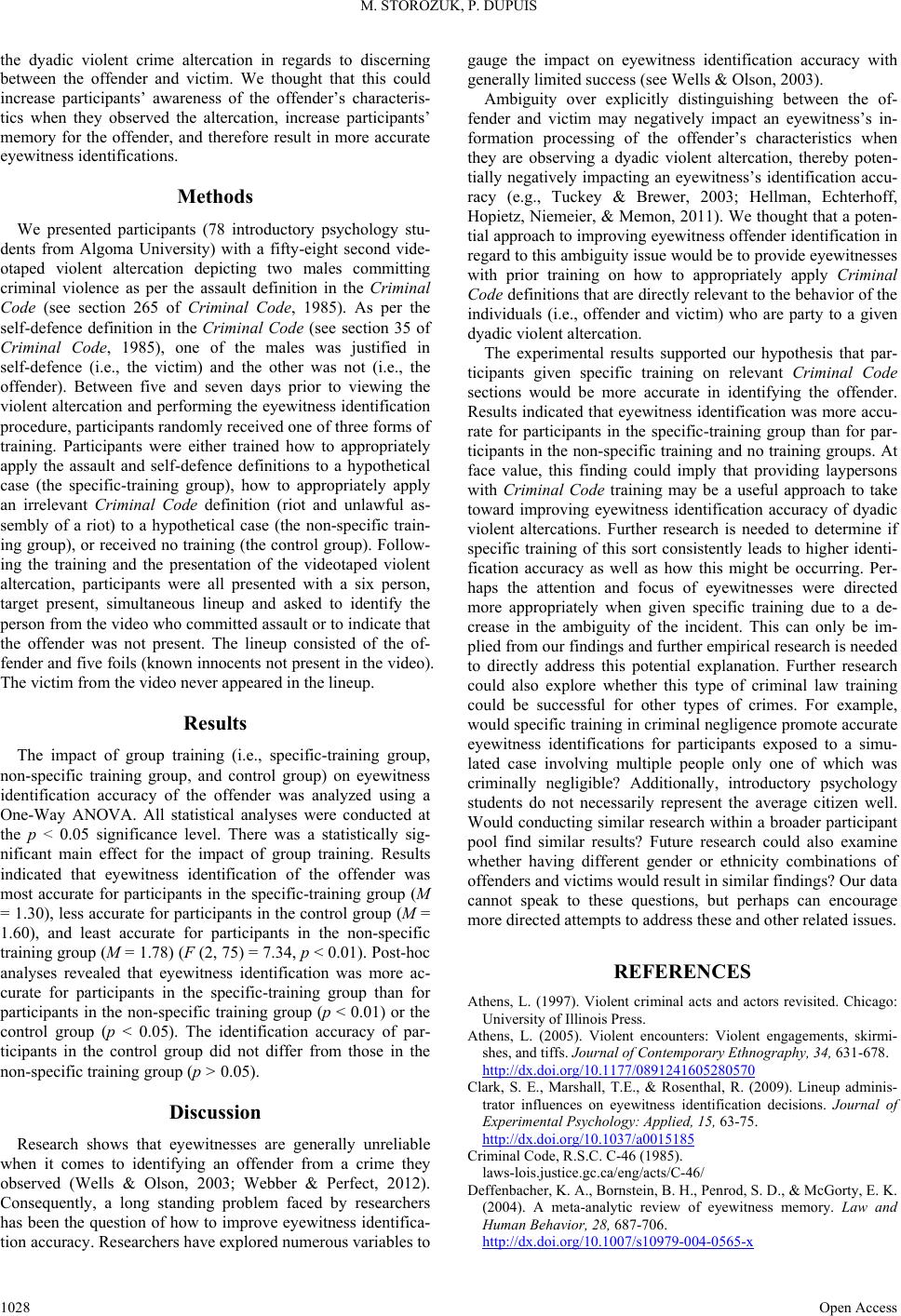
M. STOROZUK, P. DUPUIS
the dyadic violent crime altercation in regards to discerning
between the offender and victim. We thought that this could
increase participants’ awareness of the offender’s characteris-
tics when they observed the altercation, increase participants’
memory for the offender, and therefore result in more accurate
eyewitness identifications.
Methods
We presented participants (78 introductory psychology stu-
dents from Algoma University) with a fifty-eight second vide-
otaped violent altercation depicting two males committing
criminal violence as per the assault definition in the Criminal
Code (see section 265 of Criminal Code, 1985). As per the
self-defence definition in the Criminal Code (see section 35 of
Criminal Code, 1985), one of the males was justified in
self-defence (i.e., the victim) and the other was not (i.e., the
offender). Between five and seven days prior to viewing the
violent altercation and performing the eyewitness identification
procedure, participants randomly received one of three forms of
training. Participants were either trained how to appropriately
apply the assault and self-defence definitions to a hypothetical
case (the specific-training group), how to appropriately apply
an irrelevant Criminal Code definition (riot and unlawful as-
sembly of a riot) to a hypothetical case (the non-specific train-
ing group), or received no training (the control group). Follow-
ing the training and the presentation of the videotaped violent
altercation, participants were all presented with a six person,
target present, simultaneous lineup and asked to identify the
person from the video who committed assault or to indicate that
the offender was not present. The lineup consisted of the of-
fender and five foils (known innocents not present in the video).
The victim from the video never appeared in the lineup.
Results
The impact of group training (i.e., specific-training group,
non-specific training group, and control group) on eyewitness
identification accuracy of the offender was analyzed using a
One-Way ANOVA. All statistical analyses were conducted at
the p < 0.05 significance level. There was a statistically sig-
nificant main effect for the impact of group training. Results
indicated that eyewitness identification of the offender was
most accurate for participants in the specific-training group (M
= 1.30), less accurate for participants in the control group (M =
1.60), and least accurate for participants in the non-specific
training group (M = 1.78) (F (2, 75) = 7.34, p < 0.01). Post-hoc
analyses revealed that eyewitness identification was more ac-
curate for participants in the specific-training group than for
participants in the non-specific training group (p < 0.01) or the
control group (p < 0.05). The identification accuracy of par-
ticipants in the control group did not differ from those in the
non-specific training group (p > 0.05).
Discussion
Research shows that eyewitnesses are generally unreliable
when it comes to identifying an offender from a crime they
observed (Wells & Olson, 2003; Webber & Perfect, 2012).
Consequently, a long standing problem faced by researchers
has been the question of how to improve eyewitness identifica-
tion accuracy. Researchers have explored numerous variables to
gauge the impact on eyewitness identification accuracy with
generally limited success (see Wells & Olson, 2003).
Ambiguity over explicitly distinguishing between the of-
fender and victim may negatively impact an eyewitness’s in-
formation processing of the offender’s characteristics when
they are observing a dyadic violent altercation, thereby poten-
tially negatively impacting an eyewitness’s identification accu-
racy (e.g., Tuckey & Brewer, 2003; Hellman, Echterhoff,
Hopietz, Niemeier, & Memon, 2011). We thought that a poten-
tial approach to improving eyewitness offender identification in
regard to this ambiguity issue would be to provide eyewitnesses
with prior training on how to appropriately apply Criminal
Code definitions that are directly relevant to the behavior of the
individuals (i.e., offender and victim) who are party to a given
dyadic violent altercation.
The experimental results supported our hypothesis that par-
ticipants given specific training on relevant Criminal Code
sections would be more accurate in identifying the offender.
Results indicated that eyewitness identification was more accu-
rate for participants in the specific-training group than for par-
ticipants in the non-specific training and no training groups. At
face value, this finding could imply that providing laypersons
with Criminal Code training may be a useful approach to take
toward improving eyewitness identification accuracy of dyadic
violent altercations. Further research is needed to determine if
specific training of this sort consistently leads to higher identi-
fication accuracy as well as how this might be occurring. Per-
haps the attention and focus of eyewitnesses were directed
more appropriately when given specific training due to a de-
crease in the ambiguity of the incident. This can only be im-
plied from our findings and further empirical research is needed
to directly address this potential explanation. Further research
could also explore whether this type of criminal law training
could be successful for other types of crimes. For example,
would specific training in criminal negligence promote accurate
eyewitness identifications for participants exposed to a simu-
lated case involving multiple people only one of which was
criminally negligible? Additionally, introductory psychology
students do not necessarily represent the average citizen well.
Would conducting similar research within a broader participant
pool find similar results? Future research could also examine
whether having different gender or ethnicity combinations of
offenders and victims would result in similar findings? Our data
cannot speak to these questions, but perhaps can encourage
more directed attempts to address these and other related issues.
REFERENCES
Athens, L. (1997). Violent criminal acts and actors revisited. Chicago:
University of Illinois Press.
Athens, L. (2005). Violent encounters: Violent engagements, skirmi-
shes, and tiffs. Journal of Contemporary Ethnography, 34, 631-678.
http://dx.doi.org/10.1177/0891241605280570
Clark, S. E., Marshall, T.E., & Rosenthal, R. (2009). Lineup adminis-
trator influences on eyewitness identification decisions. Journal of
Experimental Psychology: A ppli ed, 15, 63-75.
http://dx.doi.org/10.1037/a0015185
Criminal Code, R.S.C. C-46 (1985).
laws-lois.justice.gc.ca/eng/acts/C-46/
Deffenbacher, K. A., Bornstein, B. H., Penrod, S. D., & McGorty, E. K.
(2004). A meta-analytic review of eyewitness memory. Law and
Human Behavior, 28, 687-706.
http://dx.doi.org/10.1007/s10979-004-0565-x
Open Access
1028